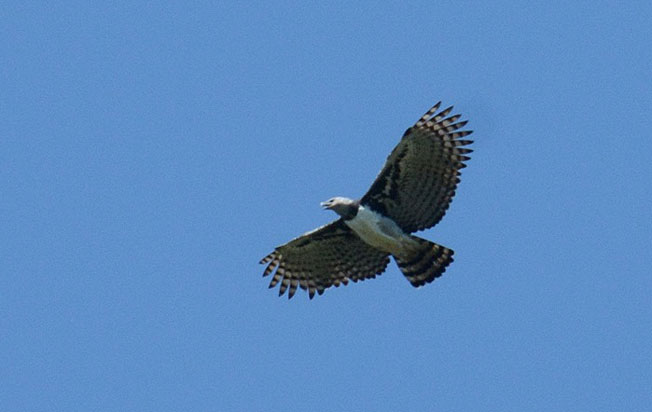Order: Accipitriformes | Family: Accipitridae | IUCN Status: Least Concern

Age: Adult | Sex: Unknown | Loc. Darien, Panama

Age: Adult | Sex: Unknown | Loc. Madre de Dios, Peru

Age: Juvenile and Subadult | Sex: Unknown | Loc. Amazonia

Age: Adult | Sex: Unknown | Loc. Amazonia, Brazil
Identification & Behavior: ~95.5 cm (37.5 in). The adult Harpy Eagle has a gray head, a black breast band, dusky upperparts. and white belly. Juveniles are pale with dusky tail and flight feathers. A juvenile takes multiple stages to attain the adult plumage. The crest is split and spiky even in juvenile birds. It is distinguished from the similar Crested Eagle by a robust body, thick legs, bigger beak, black breast band in adults, white belly, and a split crest. It forages in the forest interior and seldom soars.
Status: The Harpy Eagle is widespread, but rare in Amazonia. It also occurs in Co, Ec, Br, and Bo.
Name in Spanish: Aguila Harpía.
Sub-species: Harpy Eagle (Harpia harpyja), Linnaeus 1758.
Meaning of Name: Harpy: L. Harpe= bird of prey, probably a mythical bird, harpuiai harpies that was half buzzard and half woman. harpyja: word that relates to the definition of Harpy
Distribution Map
 Voice
Voice
 Voice
VoiceReferences:
-
- Species range based on: Schulenberg, T. S., D. F. Stotz, and L. Rico. 2006. Distribution maps of the birds of Peru, version 1.0. Environment, Culture & Conservation (ECCo). The Field Museum. http://fm2.fieldmuseum.org/uw_test/birdsofperu on 01/01/2015.